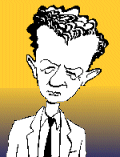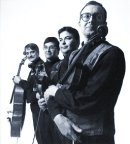
Benjamin Britten
Twentieth Century English music can be divided into two camps. Firstly, the Romantic, pastoral style most commonly associated with English music, exemplified by Elgar, Vaughan Williams, Delius and Walton.
On the other side is Benjamin Britten.
Where his predecessors found inspiration within an ever-shrinking English tradition, Britten looked forward and outwards to the modernists, especially Mahler, Bartok, Stravinsky and Prokofiev.
He also became friends with Dmitri Shostakovich and Mstislav Rostropovich for whom he wrote his cello suite.
Born in 1913, Britten became England's most outstanding composer of the post-war era. His music was original, yet retained a definite English character.
In 1945 he wrote his most famous work, the opera
Peter Grimes, about a rough but poetic fisherman, an outsider who does not fit in with society, eventually resulting in his suicide.

Benjamin Britten
Britten's idea of the outsider is more than just artistic effect. He described his own situation as triple cursed - an artist, a pacifist and a homosexual. In 1939 with the threat of war, finding the musical and social scene in England constricting, Britten moved to the United States with his lifelong partner, the tenor Peter Pears.
The years after their return to England in 1942 were the most productive and influential for Britten. The next few years produced
Peter Grimes,
The Young Person's Guide to the Orchestra and his
String Quartet no.2.
Like the
Young Person's Guide which is based on a theme by Henry Purcell, the second String Quartet was written to commemorate the 250th anniversary of the death of Purcell, including Purcellian themes and structures. The final movement,
Chacony or chaconne is a tribute the Purcell's style.

Magini Quartet
Britten wrote three numbered string quartets and a few other short suites for the quartet ensemble. In a century dominated by the string quartets of Bartok and Shostakovich, Britten's number 2 is a isolated masterpiece of a genius. This is as powerful, astonishing and emotionally draining as any work for the genre ever written.
The first movement is in an intricate sonata form, but expanded and expansive. The middle movement, a
Scherzo is short, brutal, malevolent.
But it is the final movement, the massive
Chacony, that is the kicker. It will blow your emotional socks off! The chaconne, a style from Purcell's time, is a ground, a simple theme repeated over and over. 21 variations follow, ever more complex, both technically and spiritually, until the whole work resolves in a devastating climax. The final result is deeply disturbing rather than reassuring.
From what recess of Britten's mind this this work come from? The reference to Purcell simply provides the framework for the piece. The content is a different matter entirely.
The answer lies in the aftermath of the war. In 1945, Britten accompanied Yehudi Menuhin on a tour of Germany to play for the survivors of the German concentration camps. What he saw there affected him deeply; the second string quartet was written on his return from that tour.
This CD also includes Britten's first String Quartet from 1941, also war-inspired, and the
Three Divertimenti for String Quartet from 1936, a string quartet in all but name. But (for me at least), its the rarely recorded String Quartet no.2 that steals the show.
Please support Good-Music-Guide.com
by purchasing this CD using this link.

Track Listing
Benjamin Britten
String Quartets Volume 1
Maggini String Quartet
Laurence Jackson - violin
David Angel - violin
Martin Outram - viola
Michal Kaznowksi - cello
String Quartet No. 1 In D Major, Op. 25
- Andante Sostenuto - Allegro Vivo
- Allegretto Con Slancio
- Andante Colmo
- Molto Vivace
String Quartet No. 2 In C Major, Op. 36
- Allegro Calmo Senza Rigore
- Vivace
- Chacony
Three Divertimenti for String Quartet
- March
- Waltz
- Burlesque